The Tennessee State Capitol sits atop of Capitol Hill, the highest point in Downtown Nashville, offering stunning views of the city. Surrounded by state government buildings, including the Tennessee Supreme Court and the Middle Tennessee Grand Division, it’s a hub of history and governance. Directly south of the Capitol, you’ll find Legislative Plaza, a public space nestled between state office buildings. To the north lies the Bicentennial Capitol Mall State Park, a large public park that traces the state’s history and geographic features. Walking through this area feels like stepping into Tennessee’s past and present, with every corner telling a story.
what is tennessee state capitol?
The Tennessee State Capitol is Nashville’s government building where Volunteer State leaders work on state affairs. Designed by architect William Strickland, this beautiful Greek Revival structure with a lantern tower serves as Tennessee’s political home, making it a rare statehouse with unique history
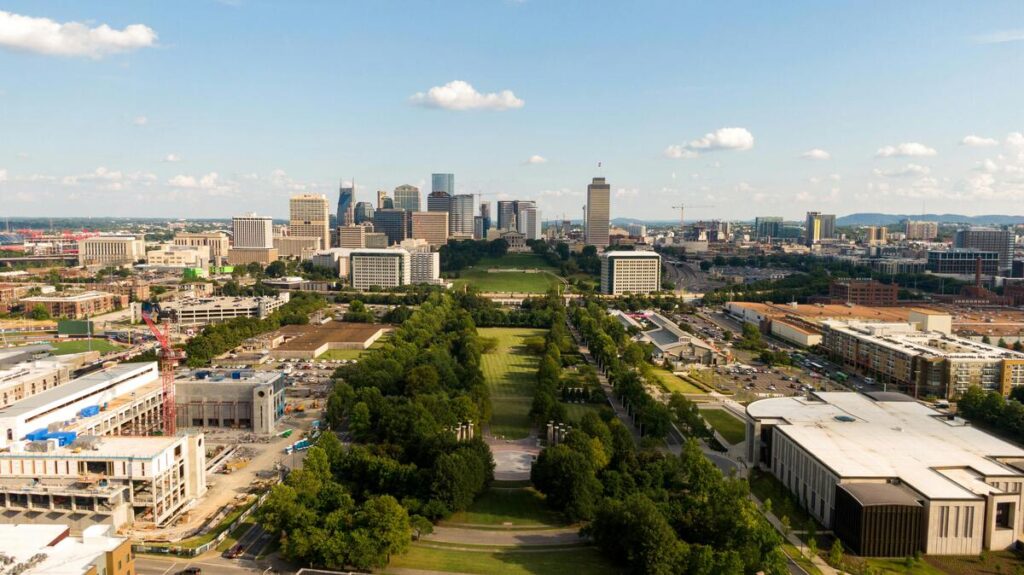
Discover the Tennessee State Capitol: A Timeless Symbol of History and Beauty
The Tennessee State Capitol, AKA the State Capitol Building, opened its doors over 165 years ago in 1859. This structure leans heavily on Greek influences, drawing inspiration from ancient Athens. Beyond its large pillars and regal appearance, it echoes the grandeur of famous structures like the Parthenon and the Temple of Apollo.
The Capitol resides on a site that once housed the Holy Rosary Cathedral, the first Roman Catholic Church erected in downtown Nashville. Today, it stands as a magnificent tribute to the people, gracefully designed and noted as a crowning achievement. The cornerstone was laid on July 4, 1845, and the finished grounds now contain statues honoring Sam Davis, Sgt. Alvin York, and Presidents Andrew Jackson and Andrew Johnson. The tombs of President James K. Polk and Mrs. Polk are also located here.
As one of the oldest working capitols in the United States, it serves as the home of the General Assembly and houses the governor’s office. A 12-state dome was added later, and in 1970, it was added to the National Register of Historic Places, becoming a National Historic Landmark in 1971. Standing near modern tourist attractions like the Country Music Hall of Fame and the Frist Art Museum, the Capitol remains a must-visit for anyone exploring Nashville.
The Tennessee State Capitol is Modeled After an Ionic Temple
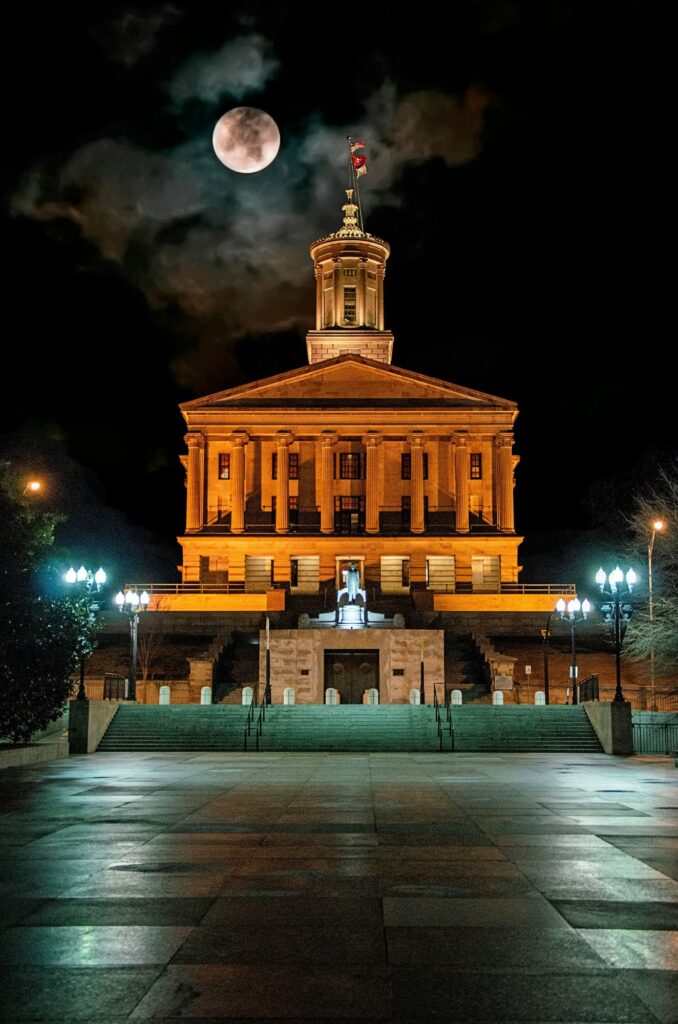
The Tennessee State Capitol is modeled after an Ionic temple, incorporating Greek Revival architecture. It is composed of limestone quarried nearby and measures 112 by 239 ft (34 by 73 m), standing approximately 206.6 ft (63.0 m) tall. The north and south porticoes each contain eight Ionic columns, while the east and west porticoes span the entire length of the structure and contain six columns. These are capped by entablatures at the top. The roof features a 42 ft (13 m) tall round tower, modeled after the Choragic Monument of Lysicrates, which sits on a square pedestal-like structure. The tower contains eight Corinthian columns and is topped by a 37 ft (11 m) tall cupola with a finial and flag pole.
The Building Contains Three Stories
The building contains three stories. The first floor contains the office of the Governor and other state officials, including cabinet members. The House and Senate chambers are found on the second floor. A room that once housed the Tennessee State Library and Archives until 1953 is also part of the building
Construction and Legacy of the Tennessee State Capitol
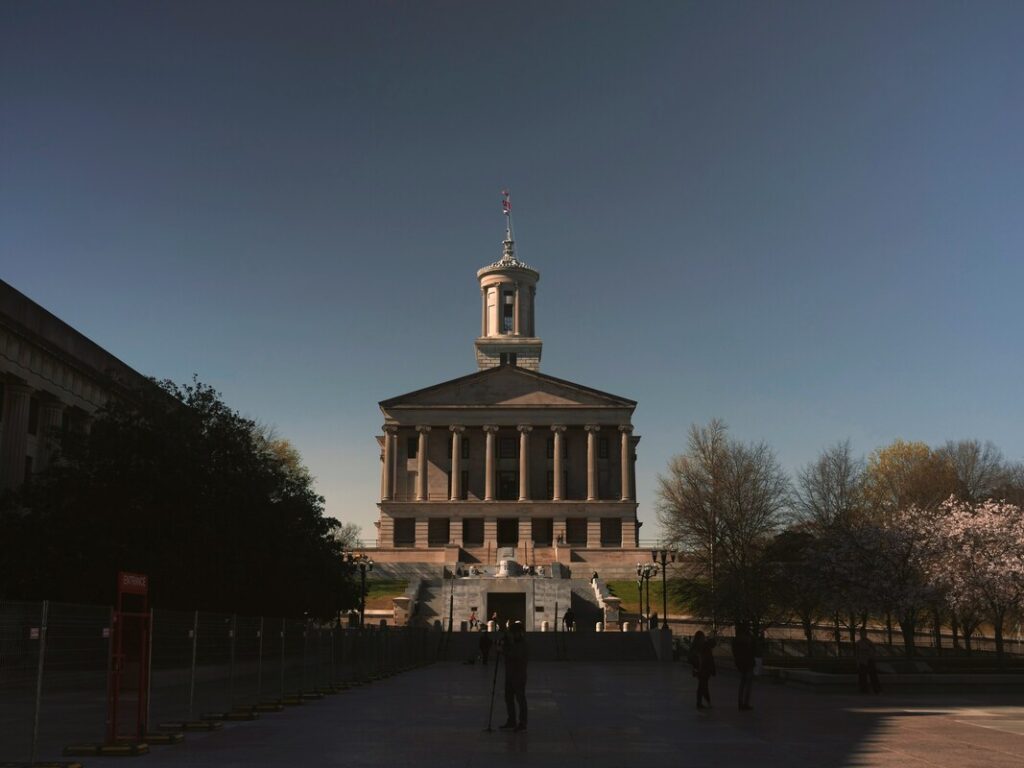
The construction of the building took 14 years to complete, beginning with the cornerstone laid on July 4, 1845, and finishing in 1859. The total construction costs were estimated at 900,000 (about 23 million in today’s money). Both the exterior and interior were constructed using Tennessee limestone, harvested from a quarry just a mile from the site. Originally, the Capitol served as the home for all three branches of state government, but today, it houses the General Assembly and the Governor’s office. The former judicial quarters are now frequently used as a media room for official press conferences.
The building previously contained the Tennessee State Library and Archives until the 1950s. A unique feature of the Capitol is its lack of a dome, making it one of only 12 state capitols without one. It also serves as the final resting place for prominent Tennesseans, including Architect William Strickland, who died suddenly in 1854 during the capitol’s construction, and Samuel Morgan, chairman of the building commission. Strickland is buried in the north facade, while Morgan rests in the southeast corner, ensuring their legacies remain tied to this prominent work.
A Graceful Masterpiece by William Strickland
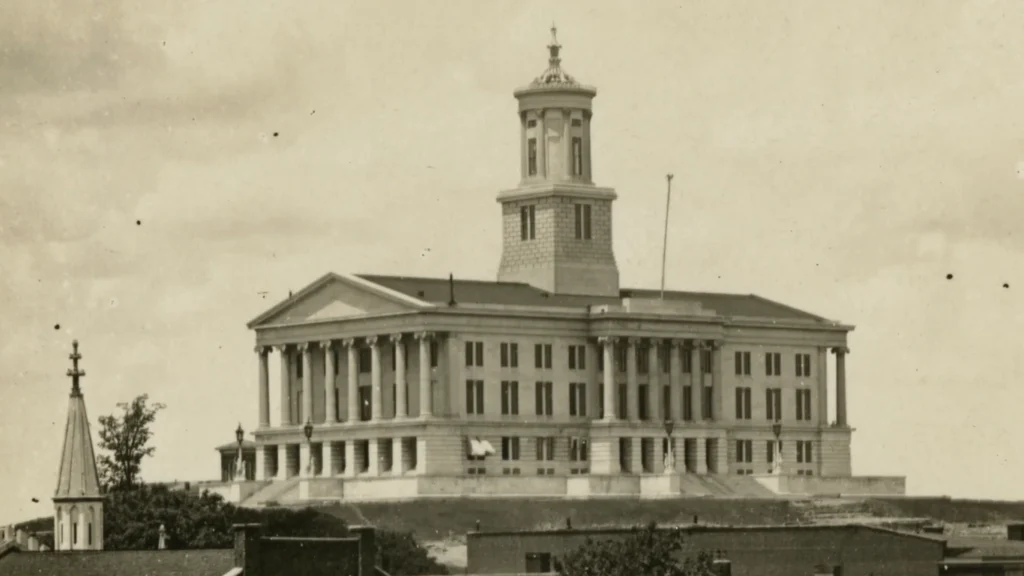
The Tennessee State Capitol, a graceful structure, stands as a crowning achievement of noted Architect William Strickland. Designed with precision, this iconic building’s cornerstone was laid on July, 4, 1845, and construction continued until its completion in 1859. Strickland, who sadly died suddenly in 1854, is buried within the Capitol’s north facade, a testament to his dedication. The Capitol’s architecture reflects his best work, blending elegance and functionality, as he imagined and believed it would. Surrounding the grounds are statues honoring heroes like Sam Davis and Sgt. Alvin York, as well as Presidents Andrew Jackson and Andrew Johnson. Additionally, the tombs of President James K. Polk and Mrs. Polk are located here, adding historical depth. Strickland’s design is often mentioned as a brilliant introduction to neoclassical architecture, making the Capitol not just a building, but a symbol of Tennessee’s rich heritage.
Tennessee’s Admission to the Union and Capital History
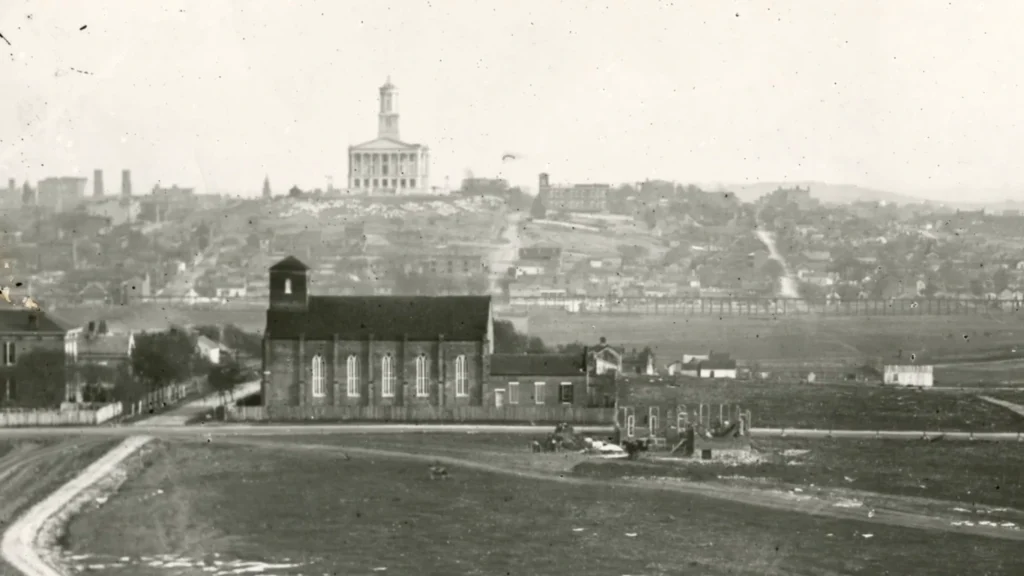
When Tennessee was admitted to the Union on June 1, 1796, it became the 16th state. Its first capital was Knoxville, but over the next thirty years, the seat of government alternated between Kingston, Nashville, Knoxville, and Murfreesboro. In 1826, the capital moved to Nashville, and the 1835 state constitution mandated that the General Assembly choose a permanent capital. On October 7, 1843, Nashville was officially declared the state’s permanent capital, and planning for the statehouse began shortly thereafter.
The Capitol was constructed on a prominent hill, initially known as Cedar Knob and later as Campbell’s Hill, named after Judge G.W. Campbell, who owned the land at the time. The site was previously occupied by the Holy Rosary Cathedral, the first Roman Catholic church in Nashville, before the property was purchased by the city and conveyed to the state government for $30,000. The design and construction of the Capitol began shortly after, marking the start of a historic landmark that continues to serve Tennessee today.
Echoes of War and Rebuilding (1861–1900)
The Tennessee State Capitol, seized by Confederate forces in 1861, became a nerve center for wartime governance until Nashville fell to Union General William S. Rosecrans in 1862, transforming it into a fortified garrison. Its limestone walls witnessed history again in 1865, as Union troops stationed there hunted John Wilkes Booth’s conspirators after President Lincoln’s assassination. Postwar, Radical Republican Governor William G. Brownlow orchestrated Reconstruction policies from its chambers, including African American suffrage (1867) and the nation’s first Ku Klux Klan Act (1870) to combat vigilante violence. Yet, by 1875, ex-Confederates reclaimed legislative power, rolling back civil rights gains—a stark contrast to the 1883 “Jim Crow” railroad segregation law debated and passed here, which foreshadowed systemic racism that endured for decades.
Silent Battles Behind Progress (1900–1950)
The Capitol’s 1920 ratification of the 19th Amendment—tipped by 24-year-old legislator Harry T. Burn’s last-minute vote—made Tennessee the “Perfect 36”, cementing its role in national suffrage. But this victory masked strife: Anti-suffragists bombarded Burn with threats, while Black women remained barred by poll taxes. The building later enshrined Confederate symbolism, like the 1926 monument to General Nathan Bedford Forrest, a slave trader and Klan leader, igniting protests. Meanwhile, 1930s WPA projects added murals romanticizing Tennessee’s agrarian past while erasing its racial inequities. During WWII, debates here over drafting women for factory work hinted at shifting gender roles, even as inequality persisted.
From Reckoning to Renewal (1950–Present)
The Capitol became a civil rights battleground: In 1960, Diane Nash and Nashville student activists confronted lawmakers after desegregating downtown lunch counters. By 1998, protests forced the removal of the Confederate battle flag from its dome. A 2016 archaeological survey uncovered enslaved workers’ tools, leading to a 2020 law mandating recognition of Black contributions. The 2016–2022 restoration (costing $126 million) addressed earthquake vulnerabilities, preserved Civil War-era graffiti like a Union soldier’s carved initials, and highlighted marginalized voices, including Native American dispossession. Today, it hosts debates on LGBTQ+ rights and education funding, while its “Suffrage Room” and President Polk’s tomb draw 250,000 annual visitors. In 2023, a statue of Senator Diane Black became the first honoring a modern female legislator, reflecting its evolving legacy.
Monuments and Memory
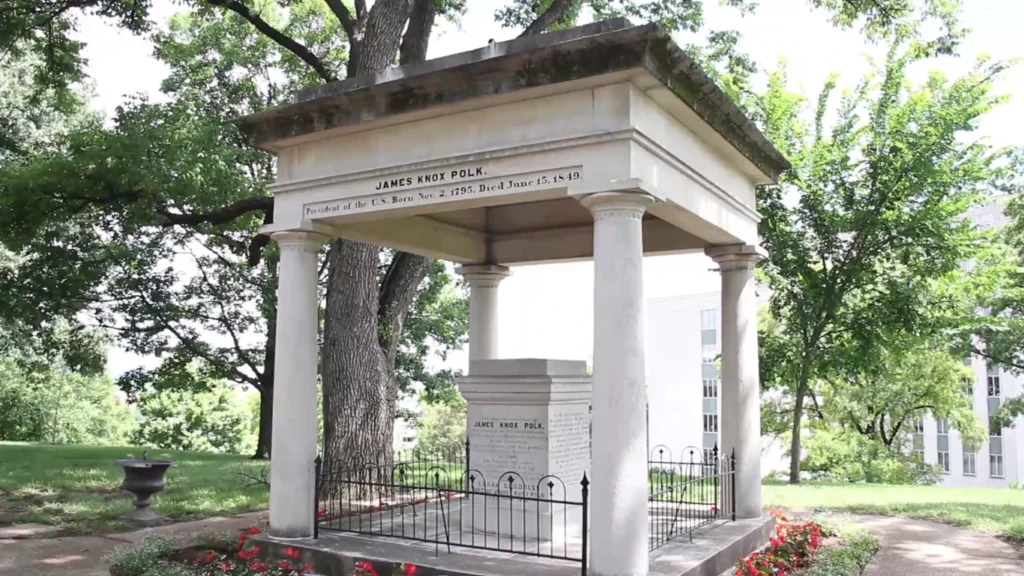
The Capitol grounds are a tapestry of history, featuring statues of three Tennessee residents who served as U.S. Presidents: Andrew Jackson, Andrew Johnson, and James K. Polk, whose tomb lies here alongside his wife, Sarah Childress Polk. Other monuments include the Sgt. Alvin C. York Memorial by Felix de Weldon, the Tennessee Holocaust Commission Memorial, and the Sam Davis Memorial. The Memorial to Africans of the Middle Passage, located at the southwest corner, honors those who suffered during the transatlantic slave trade. Nearby, the Charles Warterfield Reliquary displays broken limestone columns saved during the mid-1950s restoration.
The grounds also memorialize other great Americans, including Senator Edward Ward Carmack, whose memorial stands on the site. A notable feature is the Tennessee Holocaust Commission Memorial, located in the southwest area of the Capitol grounds, serving as a poignant reminder of history.
Controversies and Change

The Capitol has also been a site of conflict. In 2020, the Sen. Edward Ward Carmack Memorial was toppled during protests following the murder of George Floyd, and the area was unofficially claimed as the Nashville Autonomous Zone. The controversial bust of Nathan Bedford Forrest, installed in 1978, was removed in 2021 after years of debate and relocated to the Tennessee State Museum. This followed legislation introduced by Democratic state senator Douglas Henry and a 25-1 vote by the Tennessee Historical Commission.
Presbyterian Church and Labor
Just blocks away from the Capitol stands the Presbyterian Church, a reminder of Nashville’s layered history. The Capitol itself was built using convict and slave labor, with fifteen enslaved Black men working under Nashville stonemason A.G. Payne from 1845 to 1847. Paid just $18 a month, their labor was integral to the project, overseen by Samuel Dold Morgan, chairman of the State Building Commission. Morgan, who died in 1880, is entombed at the Capitol’s southeast corner, a silent witness to the contradictions of progress.
Tennessee State Capitol’s Role in Government
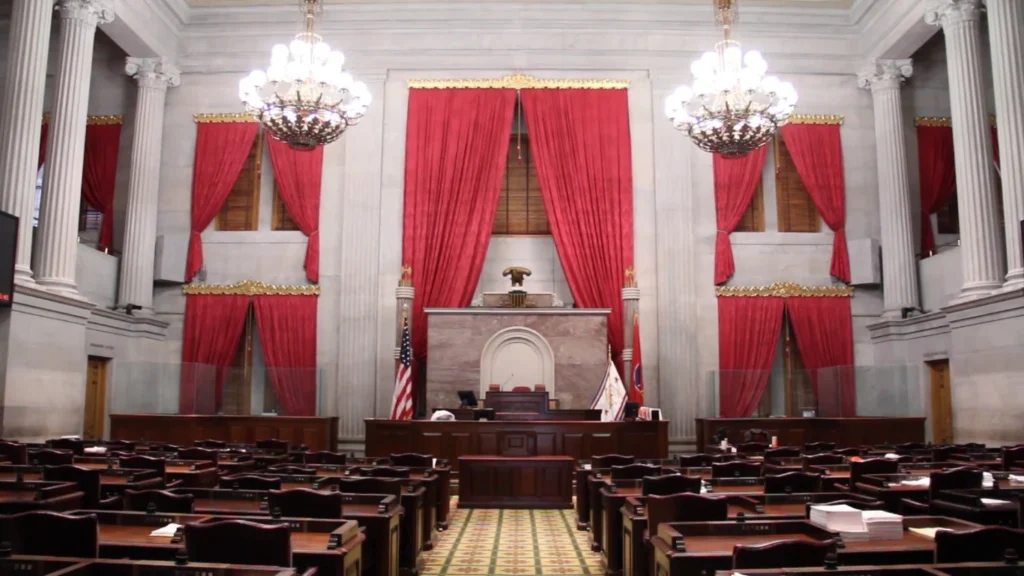
The Tennessee State Capitol, one of the oldest US capitol buildings still in use today, plays a vital role in state and national politics. Located in Nashville, this historic building houses the state Senate and the state House of Representatives, where legislative functions are carried out. It is also a site of public interest, offering free viewing opportunities for visitors, though capacity may be limited. The Capitol holds a proud position in American history, particularly as the location where the 19th Amendment was ratified on August 18, 1920—a historic moment that marked a victory for the women’s suffrage movement and finally allowed voters of all genders the unequivocal right to vote in American elections.
Today, the Tennessee State Capitol remains a major player in American politics, representing the great state of Tennessee and its highly involved residents, who are deeply engaged in local, state, and national politics. The building previously contained the Tennessee State Library and Archives until the 1950s. A unique feature of the Capitol is its lack of a dome, making it one of only 12 state capitols without one. It also serves as the final resting place for prominent Tennesseans, including Architect William Strickland, who died suddenly in 1854 during the capitol’s construction, and Samuel Morgan, chairman of the building commission. Strickland is buried in the north facade, while Morgan rests in the southeast corner, ensuring their legacies remain tied to this prominent work.
David Carpenter on the Tennessee State Capitol
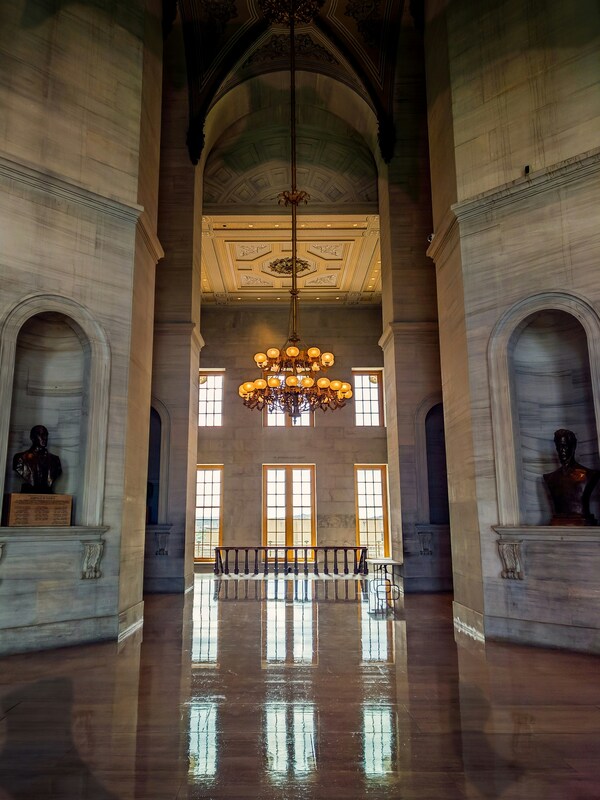
David Carpenter, who has managed the Tennessee State Capitol since 2009, describes it as a captivating architectural jewel. Perched on Nashville’s tallest hill, it features 42-foot ceilings and single-piece limestone columns in the House chamber, a daunting feat in the 1850s. The north balconies offer stunning views of the Bicentennial Mall and surrounding areas.
DES (Department of General Services) maintains the Capitol, with Metro DES providing hot and chilled water for heating and cooling since 1970. The current thermal plant, built in 2003, ensures efficient climate control.
Carpenter oversees the Capitol Complex, including the state Capitol, War Memorial Building, and Legislative Plaza. His role involves facility maintenance, event management, and customer service, which he likens to a “long-tailed cat in a room full of rocking chairs”.
He takes pride in serving Tennessee’s people and encourages tours to appreciate the building’s architectural significance and historical legacy.
Facts About the Tennessee State Capitol
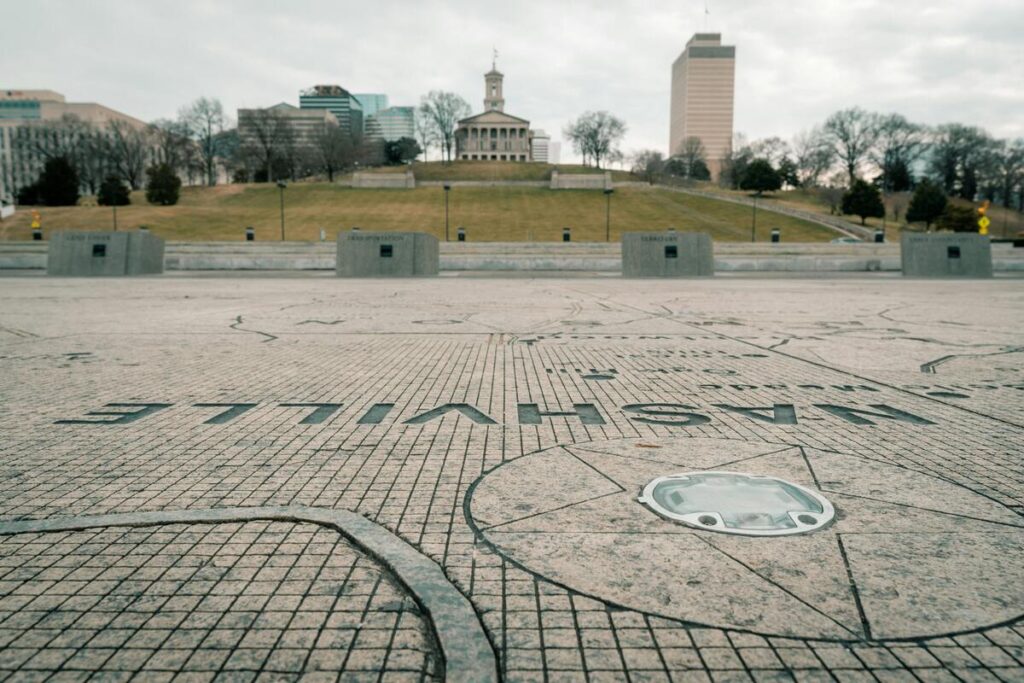
The Tennessee State Capitol, featured in the book Tennessee State Capitol: A Tennessee Treasure by Dr. Wayne C. Moore, is a historic landmark filled with fascinating stories. Commissioned by the Tennessee Secretary of State, the book highlights little-known facts about the Capitol, the oldest working statehouse in the U.S.
Nashville wasn’t always the capital; it moved from Knoxville to Murfreesboro and even Kingston before settling in Nashville in the 1830s. The city’s leaders purchased the site—Nashville’s highest point—for $30,000 and donate to the state to ensure the Capitol’s construction. William Strickland, a Philadelphia architect who apprenticed under the builders of the U.S. Capitol, designed the Tennessee Capitol. Its Greek-inspired architecture, modeled after the Choragic Monument of Lysicrates in Athens, reflects the era’s admiration for Greece as the birthplace of democracy. The building’s limestone was quarried locally from Samuel Watkins’ property, with Nashville’s first paved road built to transport the stone.
Construction began in 1845 and was completed in 1859, but landscaping was delayed due to the Civil War. During the war, the Capitol became a Union fort, complete with cannons and a palisade. Remnants of this era, including Union soldiers’ graffiti, can still be seen in the towers.
Dr. Moore, a former Assistant State Archivist, emphasizes the Capitol’s role as a symbol of Tennessee’s vibrant democracy and its importance in the 1840s and 1850s, when it was home to national leaders like Andrew Jackson. He notes that the Capitol was once the center of all state government functions, housing every branch of government.
The Capitol’s gravitas comes from its locally sourced limestone, quarried from Samuel Watkins’ property. Watkins, whose legacy includes Watkins College, allowed the state to quarry the stone for a few thousand dollars. The first paved road in Nashville was built to haul the stone to the construction site.
Today, the Capitol stands as a testament to Tennessee’s rich history, with its Greek-inspired design, Union soldiers’ graffiti, and role as a symbol of democracy.
Capitol Welcomes Visitors for Tours
In modern times, the Tennessee State Capitol invites visitors to explore its historic grounds for tourist or educational purposes. The Capitol offers both guided and self-guided tours, providing a range of experiences for all—whether you’re on couples walks, visiting Nashville with Teens, or just love history. Guided tours of Capitol Hill are available from 8:00 a.m. to 4:00 p.m. on weekdays, often in collaboration with the Tennessee State Museum, and remain free for the public. These 45-minute tours begin on the hour at 9:00 a.m., 10:00 a.m., 11:00 a.m., 1:00 p.m., 2:00 p.m., and 3:00 p.m. Central Time, starting at the first-floor information desk on a first-come, first-served basis.
Upon arrival, visitors should use the west entrance, where security checks are conducted. An alternative entrance is available through the strangest hidden route—the Motlow Tunnel on State Capitol Drive (off Dr. Martin L. King, Jr. Blvd)—though it requires climbing stairs to access the west entrance. Inside, the public galleries allow the general public to view the proceedings of the Senate and House of Representatives, though availability may vary. For a more immersive experience, self-guided tours offer a deeper look into the Capitol’s history. After your visit, cross the John Seigenthaler Pedestrian Bridge for skyline views, or if you prefer indoor exploring, pair your trip with a visit to The Parthenon Nashville. Rain or shine, it’s a perfect stop before diving into late-night fun downtown.
Self-Guided Tour
For those who prefer to explore at their own pace, self-guided tours are available from Monday to Friday, 9:00 a.m. to 4:00 p.m. Central Time.
Guided Group Tours
Groups of 10 or more can schedule a guided tour in advance by filling out a reservation form or calling 615-741-0830. These group tours feature highlights such as the first floor, including the Old Supreme Court Chamber and main hallway, as well as the second floor, which includes the House and Senate chambers and the Legislative Lounge.
Tennessee State Museum and Tennessee State Capitol Policies
In modern times, visitors are welcome to explore the Tennessee State Capitol for tourist or educational purposes. Tours of Capitol Hill are generally conducted as guided tours from 8:00 a.m. to 4:00 p.m. on weekdays. These tours are often offered in conjunction with the Tennessee State Museum and are free to the public. Tours begin on the hour at 9:00 a.m., 10:00 a.m., 11:00 a.m., 1:00 p.m., 2:00 p.m., and 3:00 p.m.
Policies
- Large bags and backpacks are not allowed inside the Tennessee State Capitol.
- Small personal bags or purses are permitted but will be checked by security upon entering the building.
- Visitors with special needs can find assistance on the accessibility page.
- Capitol staff and self-guided brochures are available at the first-floor information desk.
- Hand sanitizing stations are located throughout the building for visitor use.
- Masks are no longer required inside the building.
- Personal photography is permitted, but the use of flash is not allowed.
Language Assistance Policy
The State Museum is committed to providing programs and services that offer educational and cultural enrichment to all visitors. Program participants who respectfully request language assistance due to a limited ability to speak or understand English are encouraged to contact the museum at least five (5) business days prior to the date of the requested program or service.
Walking, Biking & Public Transportation
The Tennessee State Capitol, a historic landmark, is centrally located in the heart of Downtown Nashville, making it easily accessible for visitors. For those who enjoy exploring on foot, Walking Tour maps are available for purchase at the Nashville Civic Design Center for just $5. These maps feature detailed routes for exploring downtown Nashville and the surrounding areas, ensuring a seamless and enriching experience.
Cyclists will find convenient bike racks located at 6th Avenue North and Union Street, providing secure parking for their bikes. Additionally, the area is served by the Nashville B-Cycle bikeshare program, with a bikeshare dock situated nearby. Visitors can easily rent bikes through the Nashville B-Cycle system, which offers affordable rates and multiple stations across the city. For more information on bike rentals, rates, and station locations, visit the official Nashville B-Cycle website.
Parking
There is no private parking available at the Tennessee State Capitol. Visitors can park in nearby paid lots or use street parking with meters. During the week, parking is limited to these options, but on weekends, visitors may park for free in the state employee parking lots surrounding the State Capitol.
Consider purchasing Tennessee State Capitol, the new Images of America book by Jeff Sellers and the Tennessee State Museum. check Availability at Tennessee State Museum Store.
Frequently Asked Questions About Tennessee State Capitol
what is tennessee state capitol called?
The Tennessee State Capitol is officially known as the Tennessee State Capitol building, recognized as one of the state’s most historic structures. Located in Nashville, this historic landmark stands where other cities like Knoxville, Kingston, and Murfreesboro once served as capital of Tennessee before Nashville became the state’s permanent capital.
When Was the Tennessee State Capitol Built?
The Tennessee State Capitol was constructed during the period spanning 1845 through 1859. Its cornerstone was established on July 4, 1845, and the structure reached construction completion when officially opened in 1859.. Architect William Strickland designed this historic building, and the construction period created the current Capitol building after Nashville became Tennessee’s permanent capital in October 1843.
Who Is Buried at the Tennessee State Capitol?
The Tennessee State Capitol’s north wall holds a crypt where Architect William Strickland is buried. Outside on the grounds, the historic graves of President James K. Polk and Sarah Polk stand as eternal monuments.
Where Is the Tennessee State Capitol?
The Tennessee State Capitol commands the highest hill in Nashville’s downtown area, standing at 600 Dr. M.L.K. Jr Blvd.. This impressive example of Greek Revival architecture overlooks the Cumberland River. The Tennessee State Capitol building serves as the capital city and seat of government for the state, positioned in the north-central part of Tennessee.
Can You Go into the Tennessee State Capitol?
Yes, the Capitol opens its doors to visitors with self-guided tours running Monday through Friday, 9 AM to 4 PM Central Time. Guided tours are also available Monday through Friday at designated times.
How Old is the Tennessee Capitol Building?
The Capitol building is 166 years old, having been completed in 1859 and standing as one of the nation’s oldest working state capitols. Visitors can visit for tours throughout the week and watch a documentary about its construction. The State Capitol also houses the State Museum exhibits.
What is the Tennessee State Capitol Name by Government?
The Tennessee State Capitol is the official name used by the State of Tennessee government in Nashville.


grpjohztpgisinrolpthsxmllpwygp
its excellent as your other posts : D, regards for posting.
zlgxywzsrydfnipigpdogyllkjxnmu